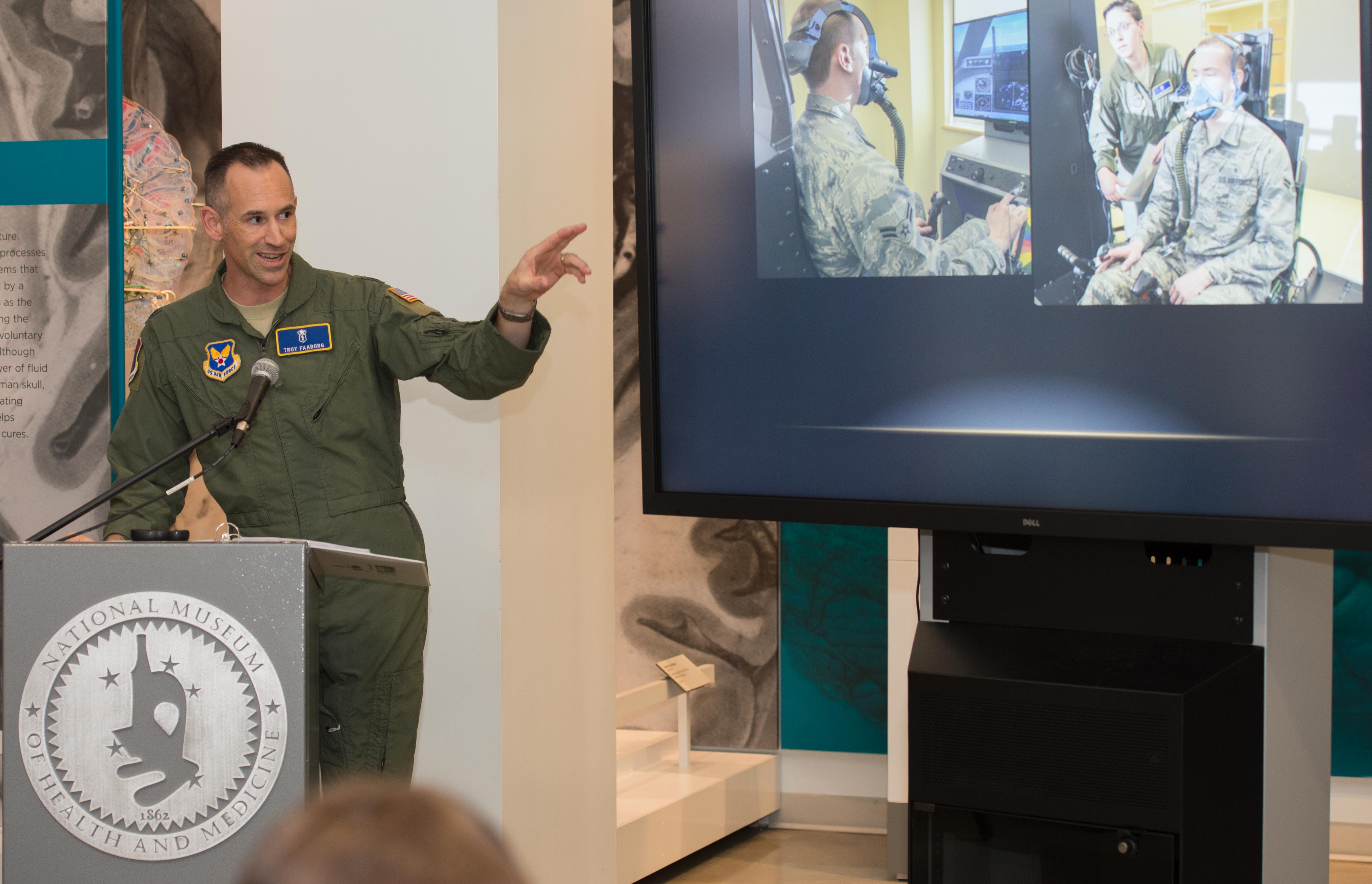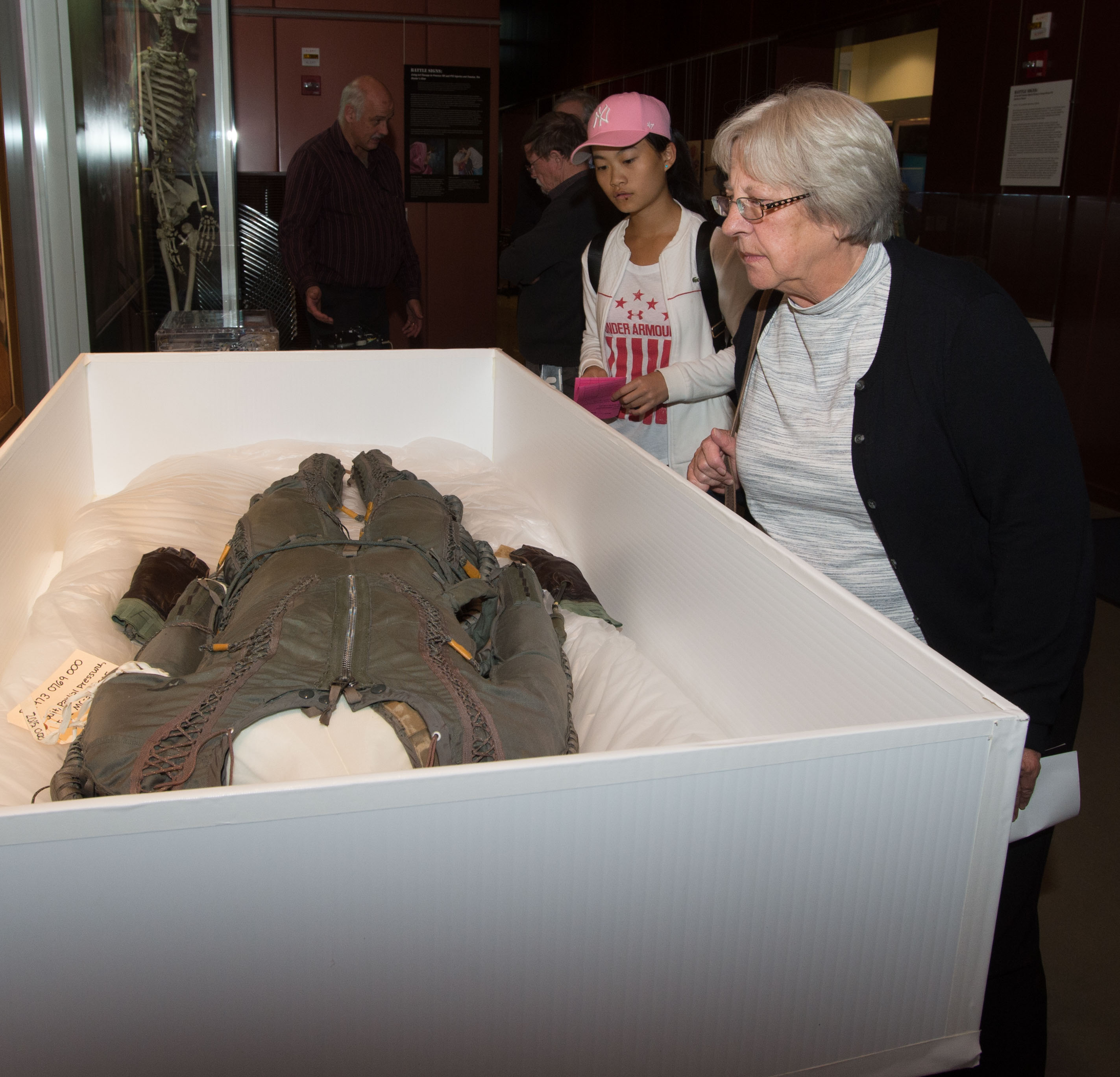Air Force Physiologist Shares How Pilots, Crew are Trained for Extreme Environments
By Lauren Bigge
NMHM Public Affairs Coordinator
The aircrew of the U. S. Air Force (USAF) must be specially trained to meet mission demands of extreme environments, Lt. Col. Troy Faaborg, USAF aerospace and operational physiology chief, told the Medical Museum Science Café audience at the National Museum of Health and Medicine (NMHM) on Oct. 24. Faaborg guides aerospace medicine professionals in working with military aviators to improve their performance in supporting Department of Defense missions at a time when technology is fast outpacing human performance.
"Aerospace and operational physiologists learn about the function of the human body; that's the physiology component," he explained. "The aerospace component is applying that knowledge of how that body functions, to how it functions in the aerospace domain."
B-2 Spirit stealth bomber missions may last 24 to 44 hours; the U-2 Dragon Lady reconnaissance aircraft can travel at altitudes exceeding 50,000 feet; missions in those types of extreme environments require a full-pressure flight suit for high-altitude protection.
More than a flight suit is needed to prepare aircrew for extreme environments, especially when a flight consists of just two pilots in the B-2 Spirit stealth bomber. The demands on pilots require a science-based and physiologically-modeled counter-fatigue plan that includes timed in-flight napping and caffeine or other stimulants prescribed by a flight surgeon. The goal is to support and protect the pilots, so they can fulfill their missions and return safely. A counter-fatigue plan is also useful for USAF personnel with other responsibilities such as snow removal, missile support, or security forces.
"My colleagues and I optimize human performance in operational environments to ensure that my friends flying that airplane can maintain our Air Force's combat effectiveness," he said, noting that aviators train for many performance challenges, including: altitude, fatigue, and spatial disorientation.
Oxygen deprivation becomes a problem at high altitudes; USAF considers altitudes exceeding 10,000 feet to be a physiologically-deficient zone. "The body, on its own, can't adapt to that lack of oxygen," he said. "We can train aircrew in a hypobaric environment that can simulate the low-pressure that you experience in flight. They experience the reduced-pressure environment, learn to recognize the symptoms of hypoxia, and put on their emergency oxygen equipment."
Aircrew training for hypoxia recognition involves a reduced oxygen breathing device (ROBD). It replicates the high-altitude partial pressure of oxygen, supplementing additional nitrogen. The ROBD is small enough to integrate into training platforms. This enables a pilot to begin experiencing hypoxia symptoms while performing an operationally-relevant task, such as flying a flight simulator.
Faaborg explained that training is also needed to handle spatial disorientation because maintaining balance and orientation in an extreme physiological environment is a challenge, with aircraft capable of rapid acceleration and deceleration, twists and turns, as well as movement in three axes. "Aircraft like the F-16 are capable of pulling nine Gs," he said, noting that "G" refers to gravity and acceleration forces. "Your body now weighs nine times what it does under normal conditions. Imagine the movement challenges alone to continue controlling your aircraft."
Aerospace physiology specialists train aircrew by spinning them around in a Barany chair, while removing their visual and auditory cues so they do not rely on false sensations. They teach how the vestibular organs (inner ear sensory apparatus) function and that aircrew should trust the flight instruments instead of sensations. The fluid-filled semicircular canals of the ear respond to angular or rotational acceleration, which leads to illusions. "In aerospace physiology, we teach how the body functions, how the aerospace forces are going to have influence on those balance and orientation organs, and what we can do to fix that," he said. "You can counter effects if you know how the body works."
"Lt. Col. Faaborg's presentation, with both a historical overview of aerospace medicine and a look to the future of aerospace medical challenges, supports NMHM's efforts to share the value of the DoD's investment in military medicine for the warfighter," said Andrea Schierkolk, NMHM public programs manager.
Science Café attendees were offered a special display of a related artifact from the museum’s collection: a Type MC-3, USAF partial-pressure flight suit from U-2 testing in the 1950s, showcased by Alan Hawk, the museum's Historical Collections manager. Hawk featured another artifact related to the presentation: an abrupt deceleration vehicle model. The 1950s-era artifact tested both human and animal subjects to help scientists understand the effects of sudden stopping on the bodies of aircrew or astronauts. NMHM’s collections include four aircraft flight helmets; a Space Tissue Loss Module from Space Shuttle Atlantis, which studied bone cell maturation under microgravity conditions; and two automated cell culture laboratories for investigating the effects of weightlessness on human cells, one "Woodlawn Wanderer Nine" intended for an Apollo mission, and one "Woodlawn Wanderer Nine" that was used in the Skylab III earth orbital mission in 1973.
NMHM's Medical Museum Science Cafes are a regular series of informal talks that connect the mission of the Department of Defense museum with the public. NMHM was founded as the Army Medical Museum in 1862 and moved to its current location in Silver Spring, Maryland, in 2012. NMHM is an element of the Defense Health Agency. For information on upcoming events, call 301-319-3303 or visit www.medicalmuseum.mil.
Click any photo to view larger version





